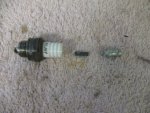gm280
Supreme Mariner
- Joined
- Jun 26, 2011
- Messages
- 14,590
I was watching some YouTube videos a few days ago and saw this video concerning spark plugs. And one thing caught my eye and I had to try it for myself. Seems you can easily make a resistive spark plug a non-resistive plug quite easily. I figured hearing that, it was some goofy idea and never work. However, I was wrong...again.
If you take a resistive spark pug and hold it with some pliers or even with a vice, you can heat the tip, the place where you normally snap on the spark plug boot, and twist it off without any effort. Just apply a standard blow torch and use a pliers and turn off the top. Yes it is threaded on...go figure. And once the tip is removed, you can flip the plug over and the resistor falls out. Of course wait until it cools off first to avoid burning your fingers. It is not connected with anything inside other then touching the tip and spark electrode when it is tighten on. Some times they have a little spring inside as well. And then you can simply cut a solid piece of wire from some solid home wire (10 or 12 gauge solid copper) about the same length as the resistor you removed. Then install it all back together again. And WALA a non-resistive spark plug now. It is that easy. So I had to try it and here is that picture as I took mine apart.
Here is one I took apart this morning with very little heat and unscrewed the tip. That part in the center is the resistor. Seems the factory only uses glue to hold the tips in place. I won't recommend this for anything serious, but just thought it was interesting to know. I will see how it runs on the Poulan leaf blower/vac and see if it actually runs now. IDK JMHO
If you take a resistive spark pug and hold it with some pliers or even with a vice, you can heat the tip, the place where you normally snap on the spark plug boot, and twist it off without any effort. Just apply a standard blow torch and use a pliers and turn off the top. Yes it is threaded on...go figure. And once the tip is removed, you can flip the plug over and the resistor falls out. Of course wait until it cools off first to avoid burning your fingers. It is not connected with anything inside other then touching the tip and spark electrode when it is tighten on. Some times they have a little spring inside as well. And then you can simply cut a solid piece of wire from some solid home wire (10 or 12 gauge solid copper) about the same length as the resistor you removed. Then install it all back together again. And WALA a non-resistive spark plug now. It is that easy. So I had to try it and here is that picture as I took mine apart.

Here is one I took apart this morning with very little heat and unscrewed the tip. That part in the center is the resistor. Seems the factory only uses glue to hold the tips in place. I won't recommend this for anything serious, but just thought it was interesting to know. I will see how it runs on the Poulan leaf blower/vac and see if it actually runs now. IDK JMHO
Last edited:



















